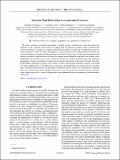Files in this item
Stochastic Hopf bifurcations in vacuum optical tweezers
Item metadata
| dc.contributor.author | Simpson, Stephen | |
| dc.contributor.author | Arita, Yoshihiko | |
| dc.contributor.author | Dholakia, Kishan | |
| dc.contributor.author | Zemanek, Pavel | |
| dc.date.accessioned | 2021-10-22T16:30:02Z | |
| dc.date.available | 2021-10-22T16:30:02Z | |
| dc.date.issued | 2021-10 | |
| dc.identifier | 276053742 | |
| dc.identifier | caf319ae-5316-4a53-a9e3-b6594649b63c | |
| dc.identifier | 85117931313 | |
| dc.identifier | 000707419400004 | |
| dc.identifier.citation | Simpson , S , Arita , Y , Dholakia , K & Zemanek , P 2021 , ' Stochastic Hopf bifurcations in vacuum optical tweezers ' , Physical Review A , vol. 104 , no. 4 , 043518 . https://doi.org/10.1103/PhysRevA.104.043518 | en |
| dc.identifier.issn | 1050-2947 | |
| dc.identifier.uri | https://hdl.handle.net/10023/24185 | |
| dc.description | Funding: We acknowledge the support from the Engineering and Physical Sciences Research Council (Grant No. EP/P030017/1), the European Regional Development Fund (Grant No. CZ.02.1.01/0.0/0.0/15_003/0000476), the Czech Science Foundation (Grant No. GA19-17765S), and the Czech Academy of Sciences (Praemium Academiae, Grant No. RVO:68081731). | en |
| dc.description.abstract | The forces acting on an isotropic microsphere in optical tweezers are effectively conservative. However, reductions in the symmetry of the particle or trapping field can break this condition. Here we theoretically analyse the motion of a particle in a linearly non-conservative optical vacuum trap, concentrating on the case where symmetry is broken by optical birefringence, causing non-conservative coupling between rotational and translational degrees of freedom. Neglecting thermal fluctuations, we first show that the underlying deterministic motion can exhibit a Hopf bifurcation in which the trapping point destabilizes and limit cycles emerge whose amplitude grows with decreasing viscosity. When fluctuations are included, the bifurcation of the underlying deterministic system is expressed as a transition in the statistical description of the motion. For high viscosities, the probability distribution is normal, with a kurtosis of three, and persistent probability currents swirl around the stable trapping point. As the bifurcation is approached the distribution and currents spread out in phase space. Following the bifurcation the probability distribution function hollows out, reflecting the underlying limit cycle, and the kurtosis halves abruptly. The system is seen to be a noisy self sustained oscillator featuring a highly uneven limit cycle. A variety of applications, from autonomous stochastic resonance to synchronization, are discussed. | |
| dc.format.extent | 13 | |
| dc.format.extent | 5934082 | |
| dc.language.iso | eng | |
| dc.relation.ispartof | Physical Review A | en |
| dc.subject | QC Physics | en |
| dc.subject | NDAS | en |
| dc.subject.lcc | QC | en |
| dc.title | Stochastic Hopf bifurcations in vacuum optical tweezers | en |
| dc.type | Journal article | en |
| dc.contributor.sponsor | EPSRC | en |
| dc.contributor.institution | University of St Andrews. School of Physics and Astronomy | en |
| dc.contributor.institution | University of St Andrews. Sir James Mackenzie Institute for Early Diagnosis | en |
| dc.contributor.institution | University of St Andrews. Centre for Biophotonics | en |
| dc.contributor.institution | University of St Andrews. Biomedical Sciences Research Complex | en |
| dc.identifier.doi | 10.1103/PhysRevA.104.043518 | |
| dc.description.status | Peer reviewed | en |
| dc.identifier.grantnumber | EP/P030017/1 | en |
This item appears in the following Collection(s)
Items in the St Andrews Research Repository are protected by copyright, with all rights reserved, unless otherwise indicated.

